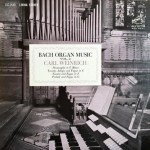 More of the music of Johann Sebastian Bach (1685-1750)
More of the music of Johann Sebastian Bach (1685-1750)
More Records that Are Good for Testing Orchestral Depth, Size and Space
Rock and Jazz Records that Are Good for Testing Ambience, Size and Space
Some audiophiles buy organ records to show off their subwoofers. Exceptional pressings of exceptional recordings such as this one will allow you to do that, but the best of them have musical qualities far beyond simple demonstrations of bass fundamentals. Carl Weinrich understands this music perfectly and makes it come alive in a way I’ve rarely heard by other performers.
For those of you who think technology marches on — which of course it does in some ways — this 1963 recording shows that the RCA engineers were capable of capturing the authentic sound of the instrument with the vintage tube equipment available to them. In my opinion they could do it better back in those days.
Musically speaking there aren’t many organists in Carl Weinrich’s class. The only other Bach organ records of this caliber that we know of are the two volumes that Karl Richter recorded for Decca in the mid-’50s. You can’t go wrong with any of them. At least one belongs in any serious audiophile’s collection.
Size and Space
One of the qualities that we don’t talk about on the site nearly enough is the SIZE of the record’s presentation. Some copies of the album just sound small — they don’t extend all the way to the outside edges of the speakers, and they don’t seem to take up all the space from the floor to the ceiling. In addition, the sound can often be recessed, with a lack of presence and immediacy in the center.
Other copies — my notes for these copies often read “BIG and BOLD” — create a huge soundfield. They’re not brighter, they’re not more aggressive, they’re not hyped-up in any way, they’re just bigger and clearer.
We often have to go back and downgrade the copies that we were initially impressed with in light of such a standout pressing. Who knew the recording could be that huge, spacious and three dimensional? We sure didn’t, not until we played the copy that had those qualities, and that copy might have been number 8 or 9 in the rotation.
Think about it: if you had only seven copies, you might not have stumbled upon the copy that sounded so exceptionally open and clear. And how many of even the most dedicated audiophiles would have more than one of two clean vintage pressings with which to do a shootout? These kinds of records are expensive and hard to come by in good shape. Believe us, we know whereof we speak when it comes to getting hold of vintage Living Stereo albums.
When you hear a copy do what this copy can, it’s an entirely different – and dare I say unforgettable — listening experience.
TRACK LISTING
Side One
Passacaglia and Fugue in C Minor
Toccata, Adagio and Fugue in C
Side Two
Toccata and Fugue in C
Prelude and Fugue in G